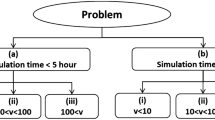Conclusions
The results of experiments with simulation and analytical models of CPU, part of which are given in Table 1, justify the following conclusions.
-
1.
The simulation model is sufficiently adequate to the modelled system fragment that using its results as a reference we can rely on the output data of the analytical model.
-
2.
The proposed analytical model is oriented toward a typical operating mode of a widespread class of computer systems. Its results, over a wide range of initial parameters, correspond to the results of the simulation and can be used for orientational estimates of the expected effectiveness of a system in the initial stage of development.
-
3.
The applied method, based on the parallel investigation of simulation and analytical models, allows us to compare homogeneous results, obtained in different ways. Such an approach may be useful in practical design of computer systems, since it gives the necessary confidence in a priori estimates, characterizing the correctness of important design decisions.
Similar content being viewed by others
Literature Cited
A. L. Sherr, An Analysis of Time-Shared Computer Systems, MIT Press, Cambridge (1965).
L. A. Belady, “A study of replacement algorithms for a virtual storage computer” IBM Syst. J.,5, No. 2 (1966).
B. S. Brawn and F. G. Gustavson, “Program behavior in a paging environment,” in: Proceedings of the AFIPS FJCC, Vol. 33 (1968).
L. A. Belady and C. J. Kuehner, “Dynamic space-sharing in computer systems,” Commun. Assoc. Comput. Mach.,12, No. 5, (1969).
E. G. Coffman and T. A. Ryan, Jr., “A study of storage partitioning using a mathematical model of locality,” Commun. Assoc. Comput. Mach.,15, No. 3 (1972).
E. G. Coffman and L. C. Varian, “Further experimental data on the behavior of programs in a paging environment,” Commun. Assoc. Comput. Mach.,11, No. 7 (1968).
G. H. Fine, C. W. Jackson, and P. V. McIsaac, “Dynamic program behavior under paging,” in: Proceedings of the 21st National Conference of the Association for Computing Machinery (1966).
Yu. L. Sokolovskii, An Algorithm for Core Allocation in a Multiprogrammed Computer System [in Russian], Preprint, Inst. Kibernetiki, Akad. Nauk UkrSSR, Kiev (1974), pp. 50–74.
I. I. Ezhov, “Markov chains with discrete random intervention, composing a semi-Markov process,” Ukrainsk Mat. Zh.,18, No. 1 (1966).
S. M. Brodi, “On a class of embedded semi-Markov processes,” in: Abstracts of Papers at the International Conference on Probability Theory and Mathematical Statistics [in Russian], Vilnius (1973).
Additional information
Translated from Kibernetika, No. 3, pp. 65–72, May–June, 1977.
Rights and permissions
About this article
Cite this article
Sokolovskii, Y.L. Estimating the effectiveness of a multiple-access computer system by analytical modelling and simulation. Cybern Syst Anal 13, 380–387 (1977). https://doi.org/10.1007/BF01069656
Received:
Issue Date:
DOI: https://doi.org/10.1007/BF01069656




